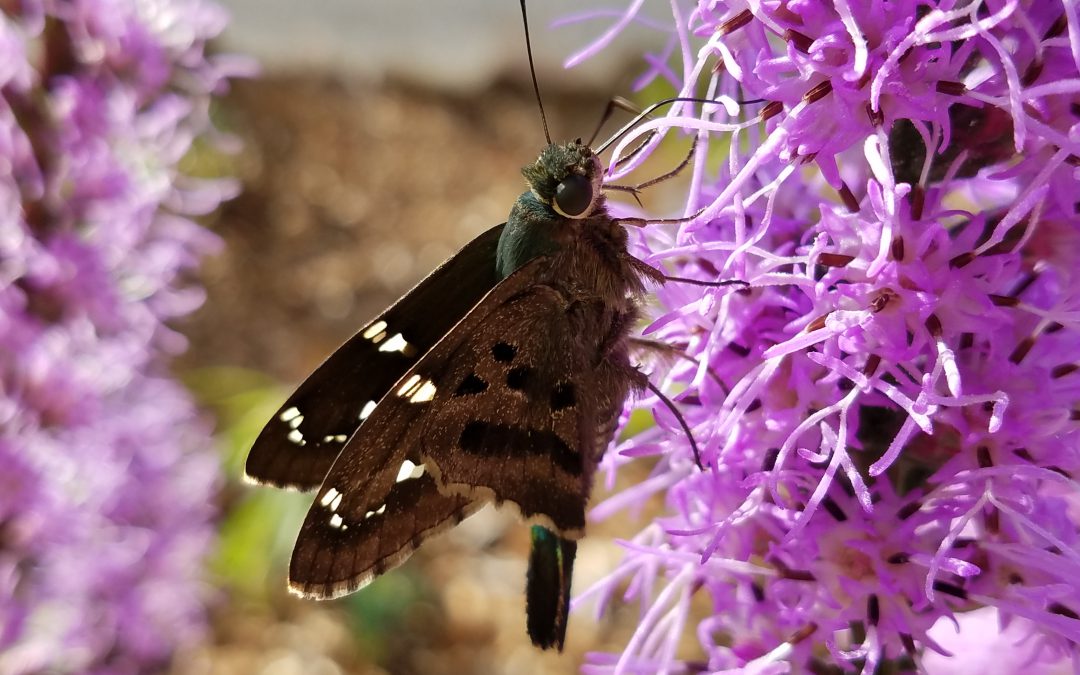
by Evan Anderson | Nov 18, 2020
We don’t always have to look closely or work hard to find beauty in our surroundings. While a well-tended landscape can certainly enhance the aesthetics of an area, there are plenty of places to find naturally attractive plants. With the benefit of being easy to care for, wildflowers are a great option for increasing the appeal of an area not just for people, but for wildlife and pollinators as well.
Not every wildflower is easy to grow or desirable in a landscape. Some have specific requirements that must be met for them to thrive, and some might be too vigorous in their growth. Invasive plants don’t make good neighbors. There are some, however, that have all the right characteristics to make them a solid choice in almost any landscape. Here are four of those that are beautiful, well adapted to the climate and soil in North Florida, and don’t necessarily make pests of themselves.
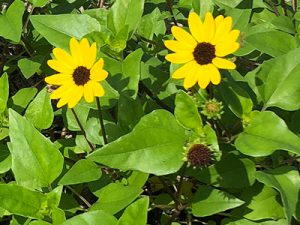
Beach Sunflower
Photo: Evan Anderson
Beach Sunflower
https://edis.ifas.ufl.edu/fp245
Helianthus debilis, also known as beach or dune sunflower, is a perennial in warmer areas, but may die back during the winter in North Florida. Different varieties may sprawl or stand upright, reaching anywhere from one to four feet in height. Blooms may be found on this plant year-round, and even in areas where it is impacted by freezes it will reseed itself.
Beach sunflower prefers a sunny location and are hardy enough to withstand some fairly marginal locations. With good salt and drought tolerance, this plant can be established in an area and left to its own devices. Too much water and fertilizer can be more of a problem for them than too little, though a little of each can help if faster growth is needed. Just be sure to give it enough room, as it likes to spread out, and be ready to trim back old growth every few months to keep plants looking good.
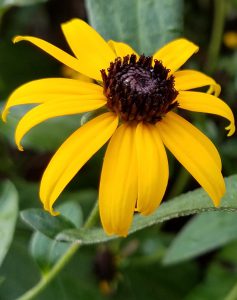
Black-eyed-susan.
Photo: Evan Anderson
Black-eyed Susan
https://edis.ifas.ufl.edu/fp512
Rudbeckia species are often known as Black- or Brown-eyed Susan. Native species and varieties can be found that are well adapted to life in Florida. With their distinctive bright yellow petals surrounding a black or brown center, Black-eyed Susans make great cut flowers and are an attractive addition to landscapes. Generally reaching one to two feet in height and spreading two to three feet, they bloom from spring to fall. Different varieties may be annual, perennial, or biennial.
Preferring full sun (though at least one variety tolerates part shade well) and well-drained soil, Rudbeckia does not mind drought or salt spray. Regular deadheading can help keep these plants looking their best.
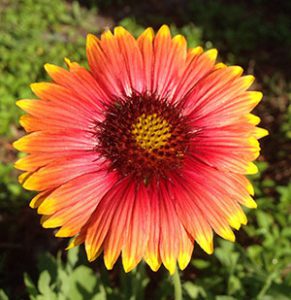
Blanketflower
Photo: Evan Anderson
Blanketflower
https://edis.ifas.ufl.edu/fp216
Gaillardia pulchella is a fiery-looking flower that provides pollinators with nectar and onlookers with a bright pop of color. Growing even in the meanest beach sand, blanketflower blooms from mid-spring to late summer, declining as weather cools. It relies upon its impressive ability to reseed itself to replenish itself each year and can spread rapidly in better soils. Those plants that do persist into cooler weather are in no need of protection, being able to withstand temperatures even into the 20s.
Relatively pest and disease free, plant this wildflower in full sun. It may tolerate some shade, but it will become leggy and creep in search of sun in such places. Dry or well-drained soil is best; certainly avoid over-watering.
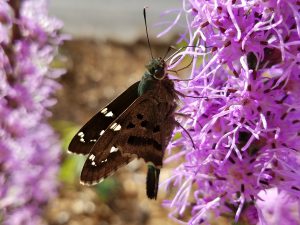
Blazing Star
https://gardeningsolutions.ifas.ufl.edu/plants/ornamentals/liatris.html
There are several species of Liatris native to Florida, any of which can be planted in the panhandle. Tall and showy, the purple blossoms open from the top of the 2-4 foot flower stalk and continue downward. They make great cut flowers and can be placed even in small gardens; while they are tall, they tend not to spread very far. Butterflies, bees, hummingbirds, and other pollinators are attracted to these plants, which tend to bloom in the fall.
Blazing star prefers to be planted in full sun, regardless of species. Well-drained soil is best, though one species, Dense blazing star, does well in moist or wet soils. These flowers do not tend to be firmly rooted, so take care when trimming back dead stems. Consider leaving the stalks alone for a while, even if they aren’t the prettiest things – they will reseed themselves and birds may enjoy making a snack of the seeds.
There are, of course, many more wildflowers out there. These are only a few of the options available. Not all wildflowers are suited to formal landscapes and may be better for informal or naturalized areas. For more information, visit the Florida Wildflower Foundation at https://flawildflowers.org/, the UF/IFAS Florida-Friendly Landscaping™ Program’s Butterfly Gardens mobile web app at https://ffl.ifas.ufl.edu/butterflies/, or the UF/IFAS EDIS publications https://edis.ifas.ufl.edu/topic_wildflowers.
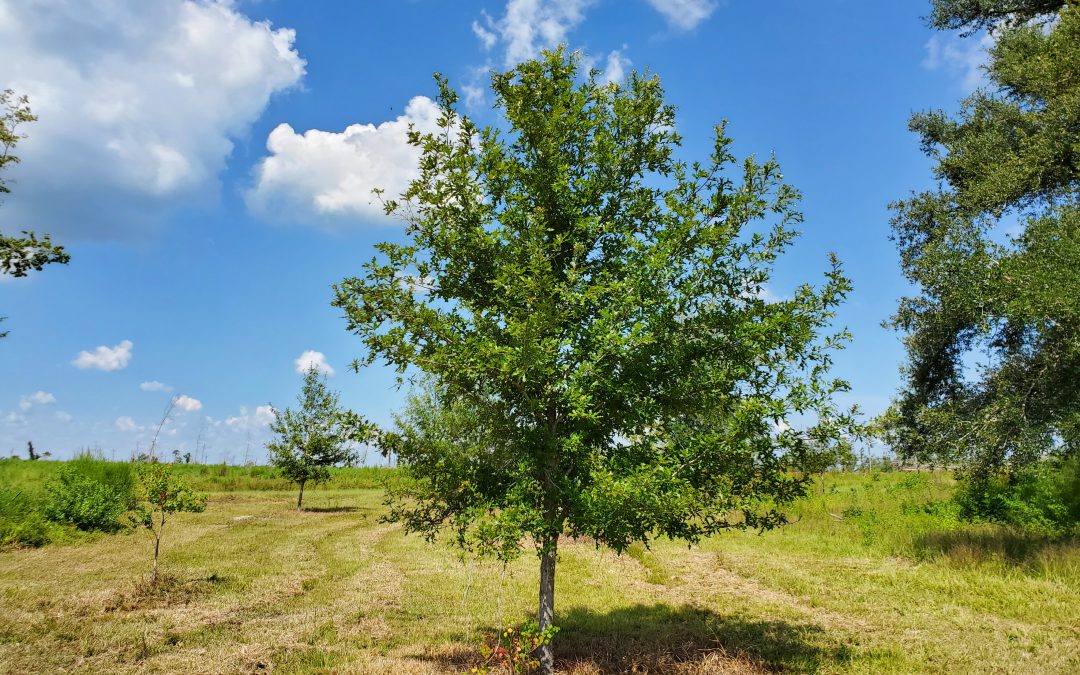
by Daniel J. Leonard | Sep 3, 2020
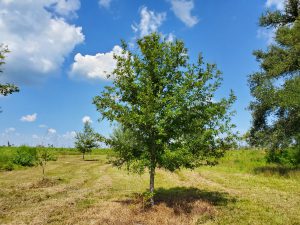
Overcup on the edge of a wet weather pond in Calhoun County. Photo courtesy of Daniel Leonard.
Haunting alluvial river bottoms and creek beds across the Deep South, is a highly unusual oak species, Overcup Oak (Quercus lyrata). Unlike nearly any other oak, and most sane people, Overcups occur deep in alluvial swamps and spend most of their lives with their feet wet. Though the species hides out along water’s edge in secluded swamps, it has nevertheless been discovered by the horticultural industry and is becoming one of the favorite species of landscape designers and nurserymen around the South. The reasons for Overcup’s rise are numerous, let’s dive into them.
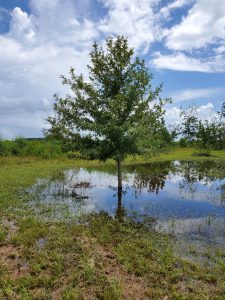
The same Overcup Oak thriving under inundation conditions 2 weeks after a heavy rain. Photo courtesy Daniel Leonard.
First, much of the deep South, especially in the Coastal Plain, is dominated by poorly drained flatwoods soils cut through by river systems and dotted with cypress and blackgum ponds. These conditions call for landscape plants that can handle hot, humid air, excess rainfall, and even periodic inundation (standing water). It stands to reason our best tree options for these areas, Sycamore, Bald Cypress, Red Maple, and others, occur naturally in swamps that mimic these conditions. Overcup Oak is one of these hardy species. It goes above and beyond being able to handle a squishy lawn, and is often found inundated for weeks at a time by more than 20’ of water during the spring floods our river systems experience. The species has even developed an interested adaptation to allow populations to thrive in flooded seasons. Their acorns, preferred food of many waterfowl, are almost totally covered by a buoyant acorn cap, allowing seeds to float downstream until they hit dry land, thus ensuring the species survives and spreads. While it will not survive perpetual inundation like Cypress and Blackgum, if you have a periodically damp area in your lawn where other species struggle, Overcup will shine.
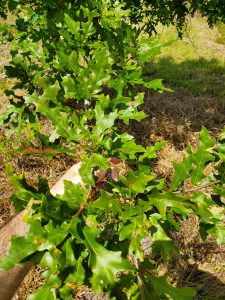
Overcup Oak leaves in August. Note the characteristic “lyre” shape. Photo courtesy Daniel Leonard.
Overcup Oak is also an exceedingly attractive tree. In youth, the species is extremely uniform, with a straight, stout trunk and rounded “lollipop” canopy. This regular habit is maintained into adulthood, where it becomes a stately tree with a distinctly upturned branching habit, lending itself well to mowers and other traffic underneath without having to worry about hitting low-hanging branches. The large, lustrous green leaves are lyre-shaped if you use your imagination (hence the name, Quercus lyrata) and turn a not-unattractive yellowish brown in fall. Overcups especially shine in the winter when the whitish gray shaggy bark takes center stage. The bark is very reminiscent of White Oak or Shagbark Hickory and is exceedingly pretty relative to other landscape trees that can be successfully grown here.
Finally, Overcup Oak is among the easiest to grow landscape trees. We have already discussed its ability to tolerate wet soils and our blazing heat and humidity, but Overcups can also tolerate periodic drought, partial shade, and nearly any soil pH. They are long-lived trees and have no known serious pest or disease problems. They transplant easily from standard nursery containers or dug from a field (if it’s a larger specimen), making establishment in the landscape an easy task. In the establishment phase, defined as the first year or two after transplanting, young transplanted Overcups require only a weekly rain or irrigation event of around 1” (wetter areas may not require any supplemental irrigation) and bi-annual applications of a general purpose fertilizer, 10-10-10 or similar. After that, they are generally on their own without any help!
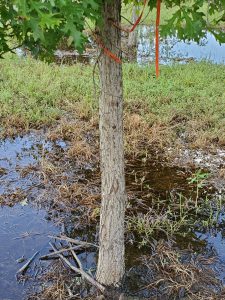
Typical shaggy bark on 7 year old Overcup Oak. Photo courtesy Daniel Leonard.
If you’ve been looking for an attractive, low-maintenance tree for a pond bank or just generally wet area in your lawn or property, Overcup Oak might be your answer. For more information on Overcup Oak, other landscape trees and native plants, give your local UF/IFAS County Extension office a call!
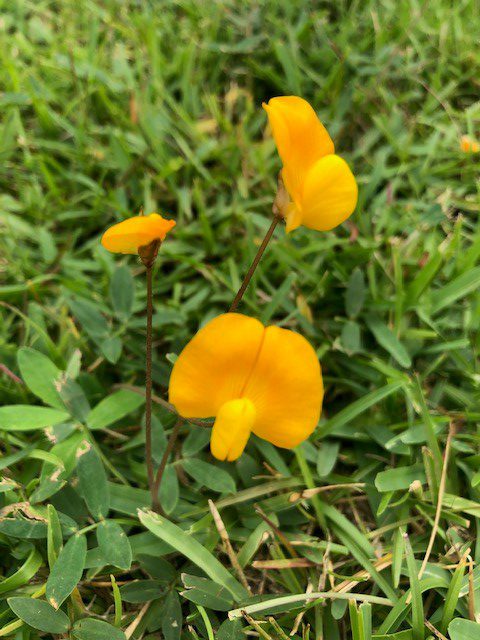
by Carrie Stevenson | Jul 2, 2020
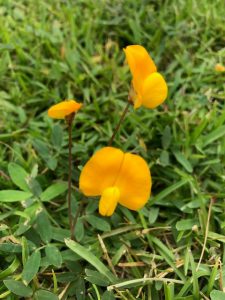
The bright yellow perennial peanut flower is not only pretty, but edible! Photo credit: Carrie Stevenson, UF IFAS Extension
It’s bright yellow, makes its own fertilizer, and tastes like peanut butter. On my morning walks around the track at our office, I have noticed lately that the perennial peanut (Arachis glabrata) is growing lushly, fulfilling its role as a low maintenance groundcover. The plant thrives in hot weather, full sun, and humidity, so we have nearly reached peak growing conditions for this South American native.
Perennial peanut was brought in from Brazil almost 90 years ago as a valuable hay crop and livestock forage. It is still used regularly for these purposes. However, as years of experience have borne out, there are no insect, disease, or unwanted invasive issues with the plant. The lush green groundcover has been used in the past few decades as a popular turfgrass alternative. It is drought and salt tolerant, and can thrive in low-nutrient, sandy soils.
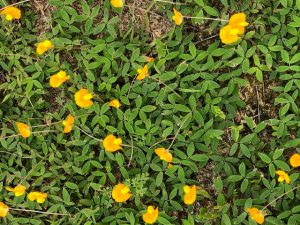
Perennial peanut is a drought-resistant, salt-tolerant, erosion-managing groundcover. Photo credit: Carrie Stevenson, UF IFAS Extension
Its bright yellow blossoms are delicate and almost orchid-like in shape, standing upright on a thin stem. As mentioned earlier, the flower is also edible and has a very light peanut flavor. The foliage, a deep green with compound leaves, lies close to the ground. Its spreading rhizomes serve as an excellent erosion control method, holding even easily washed out sandy soils in place.
Like its more well-known cousin, the perennial peanut is a legume, which means it can “fix” atmospheric nitrogen, transforming it into a form the plant can use. For a homeowner, this means you do not need to add nitrogen fertilizer. If phosphorus levels are naturally high enough in the soil (as is often the case in south Florida), only small amounts potassium-magnesium sulfate may be needed.
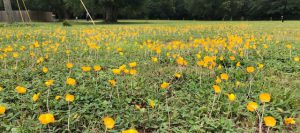
Perennial peanut is a great choice in open areas. Photo credit: Carrie Stevenson, UF IFAS Extension
Perennial peanut is best utilized in open spaces without high foot traffic. If you’d like to see it, come out to the Escambia Extension office; there’s a large swath of it between our main building and the demonstration garden near the walking path. If you are interested in planting or maintaining it, check out these documents from UF IFAS Extension or watch this informative video from a colleague!
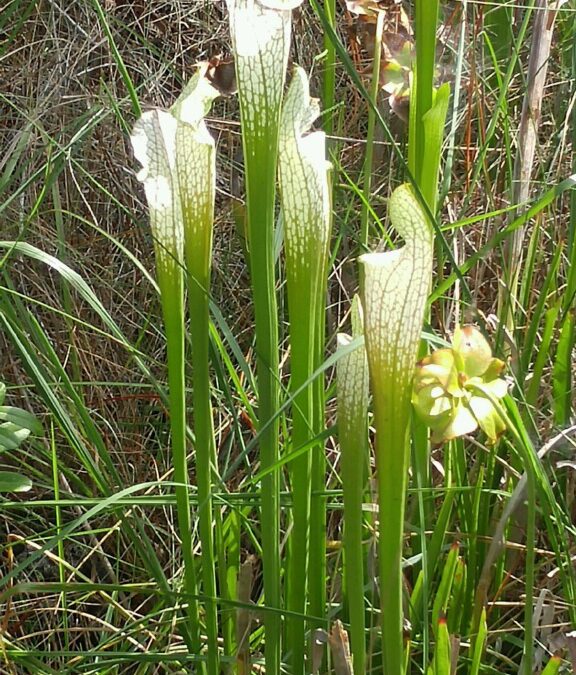
by Carrie Stevenson | Apr 30, 2020
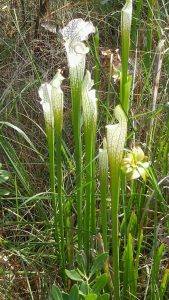
White-topped pitcher plants in bloom at Tarkiln State Preserve. Photo credit: Carrie Stevenson, UF IFAS Extension
If you live in northwest Florida or southeast Alabama and have never laid eyes on our wild native carnivorous plants, it is about time! April and early May are the best time to see them in bloom. We have six species of pitcher plants (Sarracenia), the most common being the white-topped (Sarracenia leucophylla). However, they come in multiple colors, from yellow and red to a deep purple, and in different sizes.
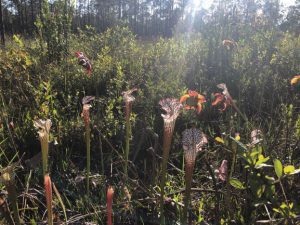
Pitcher plants and their pinwheel-shaped flowers at Splinter Hill Bog. Photo credit: Carrie Stevenson, UF IFAS Extension
One thing they have in common, though—they eat meat. Carnivorous plants all over the world have evolved in places that left them few other options for survival. These plants are typically found in extremely wet, acidic, mucky soils with very low nutrient levels. Normally, plants uptake nutrients like nitrogen and phosphorus from the soil around them. Not being available in these particular environments, carnivorous plants (or more specifically, insectivorous) developed a way to extract nutrients from insects.

Small parrot pitcher plants lie on the ground instead of standing upright at Blackwater State Forest. Photo credit: Carrie Stevenson, UF IFAS Extension
So how does it work? Pitcher plants have a modified leaf, which instead of lying out flat like most plants, is rolled up into a tube, or “pitcher” shape. The inside of the pitcher has a sweet sap, and the walls of the tube are lined with tiny, downward-pointing hairs. Separate from the leaf, the plant has an elaborate flower structure, which attracts insects for pollination. While nearby, these insects are also attracted to the colorful leaf and the sweet sap in its pitcher. The insect will land on the lip of the leaf, then crawl down.
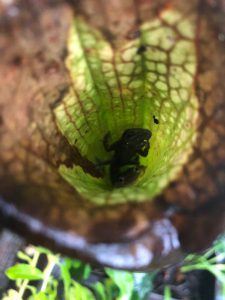 Those sticky, downward facing hairs are a trap, preventing insects from leaving the pitcher. Enzymes—a cocktail of proteins naturally found in many other plants but used creatively here—in the sap break down the bug bodies and convert them to nutrients for the plant. In fact, if you slice a cross-section into a pitcher wall or break open a dried one, you will see countless dried exoskeletons at the bottom of the tube. Several other enterprising species have taken advantage of the pitcher plant’s creative structure. More than once, I have seen tiny spiders spin webs across the mouth of the tube, or small lizards and frogs at the bottom, waiting patiently for prey.
Those sticky, downward facing hairs are a trap, preventing insects from leaving the pitcher. Enzymes—a cocktail of proteins naturally found in many other plants but used creatively here—in the sap break down the bug bodies and convert them to nutrients for the plant. In fact, if you slice a cross-section into a pitcher wall or break open a dried one, you will see countless dried exoskeletons at the bottom of the tube. Several other enterprising species have taken advantage of the pitcher plant’s creative structure. More than once, I have seen tiny spiders spin webs across the mouth of the tube, or small lizards and frogs at the bottom, waiting patiently for prey.
Some of the best places to see pitcher plants in the area—they also bloom in October—are Tarkiln Bayou State Preserve, Weeks Bay National Estuarine Research Reserve, Splinter Hill Bog Preserve, and Blackwater State Forest.
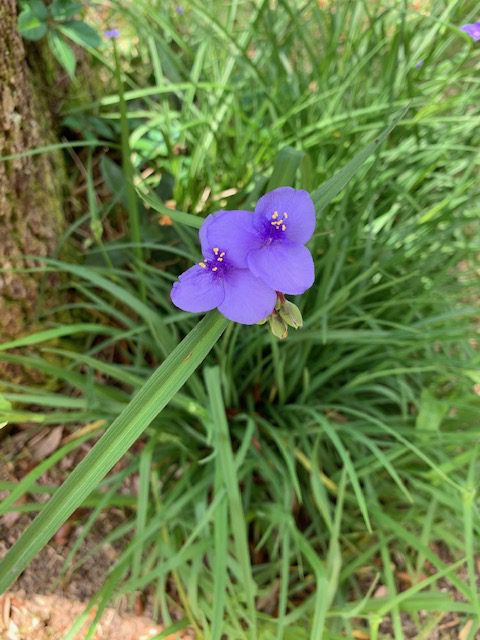
by Carrie Stevenson | Apr 24, 2020
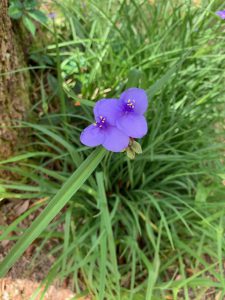
The brilliant purple, edible spiderwort flowers are only around for a day! Photo credit: Mary Anne Tomlinson
The spiderwort is a pretty little plant that most people have encountered in their yards or on roadsides. In cattle or hay pastures, it is considered a weed because cows won’t eat it, and its high moisture content can ruin hay harvests. In a home landscape, though, it can be a nice addition to the yard. I know many homeowners who refuse to let them be mowed down with the lawn simply because of their brilliant color. The native spiderwort (genus Tradescantia) is a perennial flower that grows in clusters, often in moist soils. It is a member of the dayflower family, which means each flower is only open for a single day. The plant, a favorite of bumblebees, can be identified quickly by its triad of violet petals and bright green, strap-like leaves.
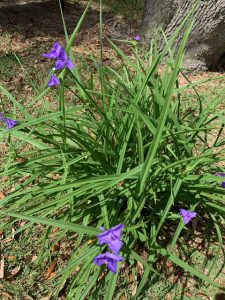
Spiderworts bloom in spring and grow in clumps of bright green, strappy leaves. Photo credit: Mary Anne Tomlinson
Known by common names as varied as “Bluejacket,” “Snotweed,” and “Cow Slobber” (due to the mucilaginous—mucus-like–consistency of its sap), the plant is widespread throughout the eastern and central United States. An interesting aspect of this sap is that it can be used as a salve for insect bites, similarly to aloe. Even more useful for those interested in native edible plants is that the flowers, stems, and leaves can be eaten raw in a salad or cooked and used as a culinary herb. The flowers can be candied with sugar as a dessert or used atop cakes.
Interestingly, the spiderwort can also indicate the presence of radiation. The bluish hairs on spiderwort flower stamens will turn pink in the presence of low levels of radiation, often more reliably than mechanical dosimeters.
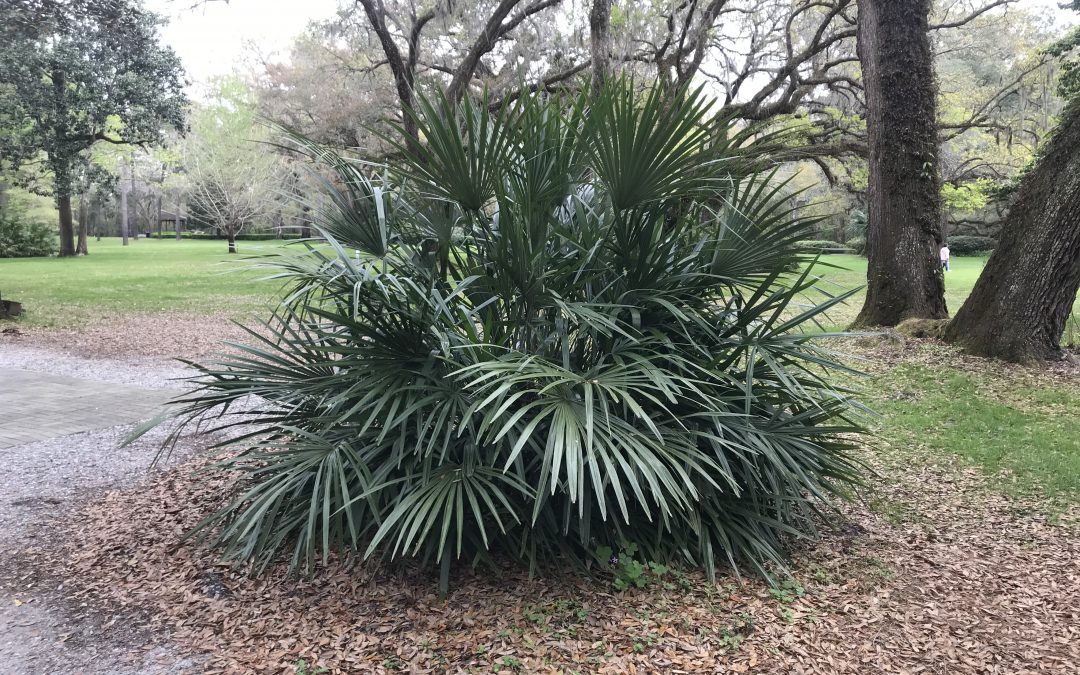
by Daniel J. Leonard | Apr 9, 2020
There aren’t a lot of quality landscape plant options that fit the description nearly every homeowner desires: native, low-maintenance, slow-growing, pest free, drought tolerant while tolerating wet soils, loving both sun or shade, and green year-round. Needle Palm (Rhapidophyllum hystrix) is the rare plant that checks all those boxes and deserves consideration when adding plants to your landscape!
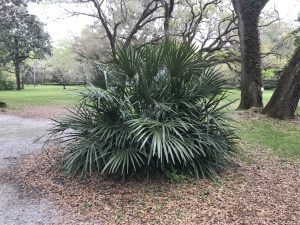
Mature Need Palm at Eden Gardens State Park in Walton County. Photo courtesy the author.
Needle Palm is an endangered native, growing in a narrow range in the coastal Southeastern US, Calhoun and Liberty counties included. It is primarily found in the understories of wet wooded areas along slopes, ravines, and bottoms; if you’ve ever hiked the Apalachicola Ravines or Torreya State Park trails, you’ve likely encountered Needle Palm in the wild! Being native is nice, but what makes Needle Palm an outstanding landscape option?
Needle Palm is the prettier, more refined cousin of Saw Palmetto (Serenoa repens), which it is sometimes confused with. Unlike the rambling, aggressive, stiff-leaved palmetto, Needle palm possesses “softer”, finely cut, lustrous evergreen leaves, allowing it to add amazing texture to any landscape. Also, unlike palmetto, it doesn’t need a yearly “cleaning” to prune out brown, dead leaves, rather its leaves persist green and clean for many years! You might not want to reach into the interior of a Needle Palm plant anyway, as generally unseen 6-8” namesake “needles” surround the base of its trunk. Needle Palm grows very slowly, eventually reaching 8’ tall or so, but is more often seen in the 4-6’ range in landscapes. This is absolutely a shrub that will never outgrow its welcome. It is a nearly trunkless palm, almost always appearing as a shrub, though with extreme old age it can begin to look a bit like a small tree with a muted trunk. With outstanding aesthetics and a low-maintenance growth habit, Needle Palm has a place in nearly any landscape.
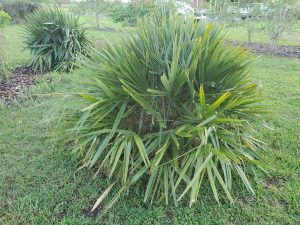
6 year old needle palm grouping growing in author’s landscape.
In the landscape, Needle Palm does best when sited with some shade in the afternoon but also thrives in full sun. They appreciate regular water during establishment but survive on their own without any extra irrigation after! Needle Palm also doesn’t need much in the way of supplemental fertilization. They do look their best with a light spring application of a general purpose, slow-release fertilizer, but this is not required. Needle Palms are not afflicted with the pest and pathogen problems the much more commonly used non-native Sago Palms (Cycas revlolutas) attracts. I’ve grown Needle Palm for 6 years in the landscape and have never noticed any pest or disease issues. With Needle Palms becoming more common in the nursery trade, I don’t see a place in most landscapes for the inferior, high-maintenance, insect infested Sagos. If you want the tropical, textured look of Sagos, plant Needle Palm instead.
Needle Palm is an extremely attractive, low-maintenance Northwest Florida native plant that you should absolutely seek out and add to your landscape! If you want more information or have any questions about Needle Palm or any other landscape/garden topic, please give us a call at the UF/IFAS Calhoun County Extension Office. Happy Gardening!

























